Sanctions Imposed on Russia Adversely Impacting U.S. Farmers and Consumers, Explained by Wells Fargo

Wells
What: |
Broadcast-ready video commentary on the impact of rising wheat and fertilizer prices stemming from the |
Why: |
Higher prices nationwide are being felt by consumers and farmers. With |
Where: |
Video news clips on |
Time codes for video clips: |
0:19 – 0:44 What do rising wheat prices mean for our grocery bills?
0:49 – 1:06 How does the conflict in the 1:11 – 1:25 How does that affect us at the grocery store? 1:35 – 2:04 How is the conflict affecting fertilizer prices?
2:10 – 2:49 How does this affect the 2:51 – 3:21 Where will the average American consumer see these price increases? 3:33 – 3:50 Do prices go up immediately or at harvest? |
1
2 Green Markets Fertilizer Price Index
3
View source version on businesswire.com: https://www.businesswire.com/news/home/20220311005221/en/
sarah.hatch@wellsfargo.com
@SarahHatchABQ
Source:







